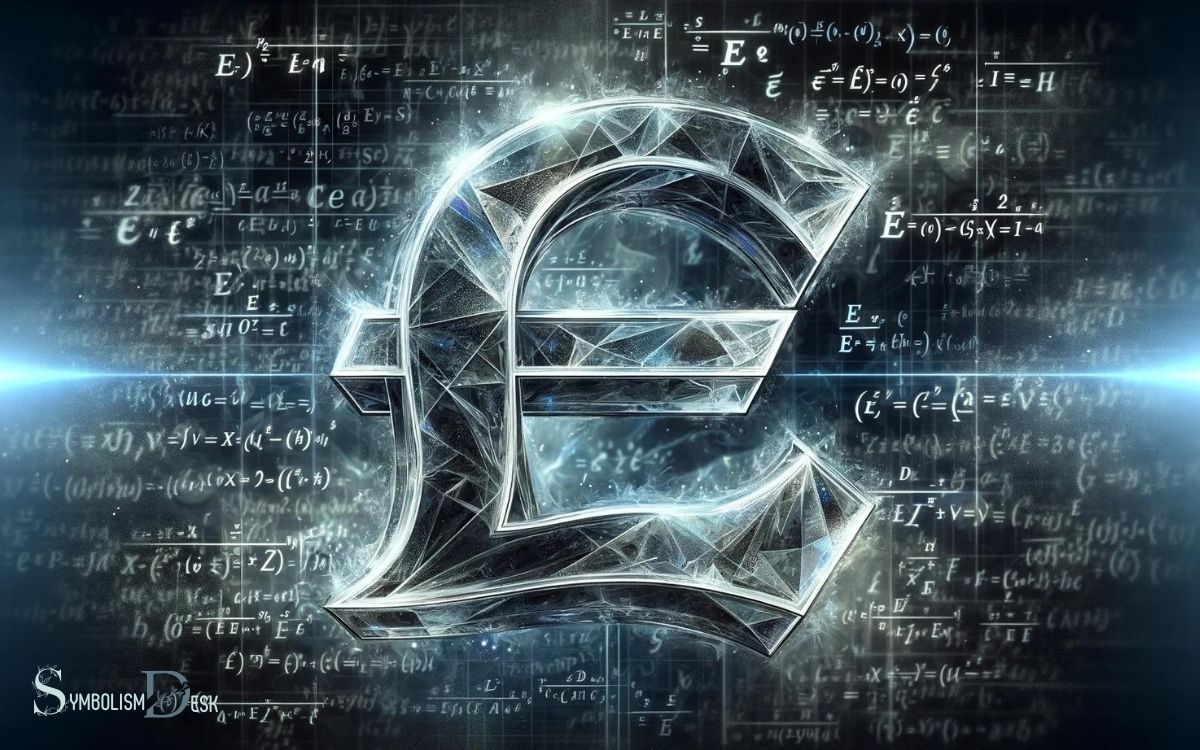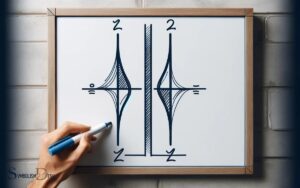What Does the E Shaped Symbol in Math Mean? There Exists!
The “E” shaped symbol in math is the existential quantifier, denoted by ∃, and it means “there exists” or “for some.” It is used to express that there is at least one element in a set that satisfies a given property or condition.
The existential quantifier (∃) is a fundamental component of predicate logic, which extends beyond basic arithmetic to more complex mathematical theories such as set theory and proofs.
Examples of its application include:
Grasping the existential quantifier is essential for understanding advanced mathematical concepts and logical expressions.

Key Takeaway
Origin and Meaning of the ‘E’ Symbol
The ‘E’ symbol in mathematics, known as the summation or sigma notation, represents the operation of adding a sequence of terms together.
The symbol originates from the Greek letter sigma, chosen for its initial in the word “sum.” When used in a mathematical expression, the ‘E’ symbol is followed by an expression written below it, indicating the terms to be summed.
For instance, ‘E’ (i=1 to n) xi represents the sum of the terms x1, x2, x3, and so on, up to xn. This notation provides a compact and efficient way to represent the addition of a large number of terms.
It is commonly used in various mathematical and scientific disciplines to succinctly express the cumulative effect of a series of values.
Mathematical Representation of ’Exists
Originating from the same mathematical notation tradition as the ‘E’ symbol for summation, the mathematical representation of ‘exists’ is a crucial concept in logic and set theory. In mathematical logic, the symbol ‘∃’ is used to express the concept of existence.
When written as ‘∃x’, it denotes that there exists at least one value of ‘x’ that satisfies a given condition. This is commonly used in statements such as “there exists a real number x such that x is greater than 3” which would be represented as ‘∃x (x > 3)’.
The symbol ‘∃’ is fundamental in quantifier logic, allowing mathematicians and logicians to express propositions about the existence of elements within a set, making it an essential tool in formalizing mathematical reasoning and proofs.
Usage in Logic and Set Theory
In logic and set theory, the symbol ‘∃’ is used to express the concept of existence, allowing for the formalization of propositions about the existence of elements within a set.
This symbol has specific applications in these fields:
- Existential Quantification: It is used to indicate that there exists at least one element in a set that satisfies a given property.
- Formalizing Statements: ‘∃’ allows for the formal representation of statements such as “There exists a prime number greater than 10” in a precise and concise manner.
- Predicate Logic: In predicate logic, ‘∃’ is essential for quantifying the existence of objects that satisfy a given predicate.
- Set Builder Notation: When defining sets, ‘∃’ is utilized to express the existence of elements that fulfill certain conditions.
- Proofs and Theorems: In mathematical proofs and theorems, ‘∃’ plays a crucial role in asserting the existence of particular elements within a set.
Existential Quantification in Mathematics
Expressing the concept of existence quantitatively, mathematics employs the symbol ‘∃’ to indicate the presence of at least one element in a set satisfying a specified property.
This notation represents existential quantification, a fundamental concept in mathematical logic and set theory. It allows mathematicians to assert the existence of an element that meets a given condition within a certain set.
For example, the statement ∃x (x > 0) asserts that there exists at least one element in the set with a property of being greater than zero.
Existential quantification plays a crucial role in formalizing mathematical statements and proofs, enabling the precise articulation of existence assertions within mathematical reasoning.
Understanding its significance in equations and inequalities provides a solid foundation for comprehending the broader applications of existential quantification in various mathematical contexts.
Significance in Equations and Inequalities
The symbol ‘∃’ holds significant importance in expressing mathematical equations and inequalities.
- It denotes the existence of at least one element satisfying a given condition.
- In equations, it allows the assertion that a solution exists without explicitly specifying it.
- In inequalities, it indicates the presence of values that satisfy the given inequality.
- It is commonly used in conjunction with logical statements to express the existence of a solution within a domain.
- Its presence in mathematical expressions enables concise and precise representation of solutions and conditions.
This symbol plays a pivotal role in conveying the presence of solutions and satisfying elements within mathematical contexts.
This significance extends to its usage in mathematical proofs, where it helps in establishing the existence of specific elements or solutions.
Applications in Mathematical Proofs
Applications of the ‘∃’ symbol in mathematical proofs play a crucial role in establishing the existence of specific elements or solutions.
When constructing mathematical proofs, the symbol ‘∃’ is used to assert that there exists at least one element in a set that satisfies a given property. This is frequently employed in various branches of mathematics, including set theory, number theory, and analysis.
The following table illustrates examples of how the ‘∃’ symbol is utilized in mathematical proofs:
| Mathematical Proof | Use of ‘∃’ Symbol | Explanation |
|---|---|---|
| Existence of Roots in Equations | ∃x | Asserts the presence of at least one solution |
| Existence of Prime Factorization | ∃p | States the existence of prime factors |
| Existence of Maximum or Minimum | ∃c | Demonstrates the existence of extreme values |
Understanding the applications of the ‘∃’ symbol is fundamental for constructing rigorous mathematical arguments.
Connection to Predicate Logic
Underpinning the applications of the ‘∃’ symbol in mathematical proofs is its deep connection to predicate logic, which provides a formal framework for reasoning about the existence of specific elements or solutions within mathematical structures.
- Predicate logic allows for the formulation of statements about properties that elements may possess.
- It enables the expression of existence and uniqueness of solutions within mathematical domains.
- The ‘∃’ symbol corresponds to the existential quantifier in predicate logic.
- Predicate logic provides a systematic way to analyze and derive conclusions about the existence of objects satisfying certain properties.
- This connection highlights the foundational role of logic in the rigorous development and validation of mathematical arguments.
Practical Examples and Exercises
Let’s explore practical applications of the E-shaped symbol in math through real-world examples and problem-solving exercises. By applying the E-shaped symbol to various scenarios, we can better understand its utility and significance in mathematical contexts.
Additionally, engaging in interactive activities involving the E-shaped symbol can enhance our comprehension and mastery of this mathematical concept.
Real-World Applications of E-Shaped Symbol
The E-shaped symbol in mathematics, known as the existential quantifier (∃), is employed to denote the existence of at least one element in a set that satisfies a given condition.
Real-world applications of the E-shaped symbol include:
- Computer Science: Used in programming to check if there exists a solution to a given problem.
- Statistics: Employed to indicate the existence of a certain value within a dataset.
- Engineering: Utilized to express the existence of a solution to an equation or the existence of a specific component in a system.
- Economics: Applied to indicate the existence of certain conditions or entities within economic models.
- Science: Used to express the existence of a particular phenomenon or element within a scientific context.
These examples demonstrate the practical significance of the E-shaped symbol in various fields.
Problem-Solving With E-Shaped Symbol
One must utilize the E-shaped symbol in practical problem-solving by rigorously defining the conditions for its existence within a given set.
For instance, when dealing with inequalities or absolute values, the E-shaped symbol represents the set of all elements that satisfy the specified conditions. One example of this is the symbol “∪”, which denotes the mathematical union of two or more sets. The importance of mathematical union lies in its ability to combine elements from different sets into one comprehensive set, allowing for more complex and nuanced analysis of data and mathematical relationships. Understanding and using mathematical union is essential for anyone working with advanced mathematical concepts or data analysis.
In a real-world scenario, such as optimizing production costs while considering different constraints, the E-shaped symbol can be used to represent the feasible region where the constraints are met.
To solve problems using the E-shaped symbol, it is essential to understand the specific conditions and constraints of the problem, and then accurately represent them using the symbol.
Through precise application, the E-shaped symbol becomes a valuable tool for problem-solving in various mathematical and real-world contexts.
Interactive E-Shaped Symbol Activities
An exploration of interactive E-shaped symbol activities will provide practical examples and exercises for a comprehensive understanding of its application in mathematics.
These activities aim to engage learners in hands-on experiences, promoting a deeper grasp of the concept.
Here are some interactive exercises to enhance understanding:
- Visual Representation: Use visual aids to demonstrate the concept of the E-shaped symbol, allowing students to see its application in different mathematical problems.
- Interactive Online Simulations: Engage in online simulations that demonstrate the use of the E-shaped symbol in various equations, providing a dynamic learning experience.
- Collaborative Problem-Solving: Encourage group activities where students work together to solve problems using the E-shaped symbol, fostering teamwork and critical thinking.
- Real-World Applications: Explore real-world scenarios where the E-shaped symbol is utilized, connecting mathematical concepts to practical situations.
- Interactive Quizzes and Worksheets: Provide interactive quizzes and worksheets to test understanding and reinforce learning.
Conclusion
The ‘E’ symbol in math is a powerful tool used to express the existence of a particular element or object within a given context. Its origins stem from logic and set theory, and it plays a crucial role in mathematical proofs and equations.
The symbol’s significance and versatility make it a shining star in the mathematical universe, illuminating the path to understanding and solving complex problems.






